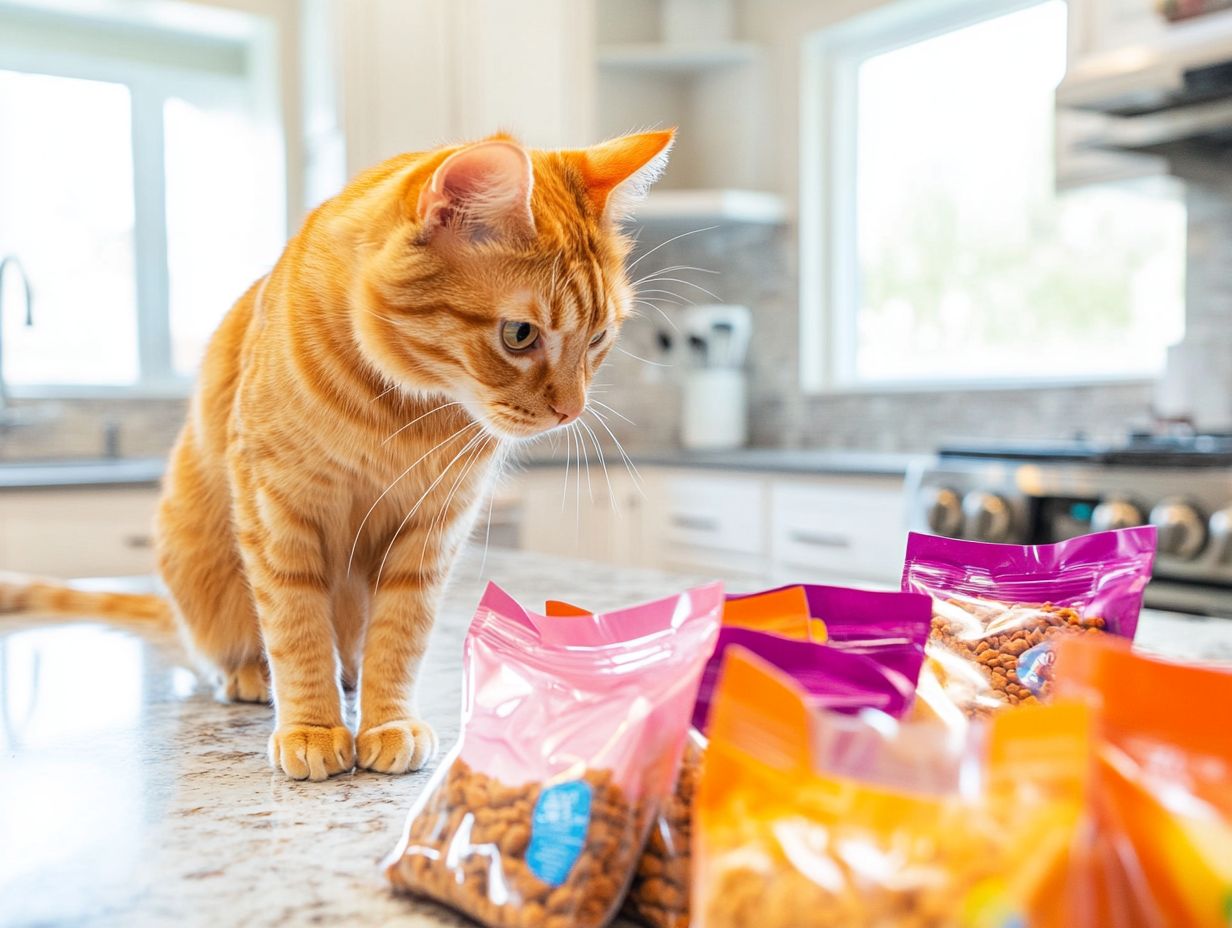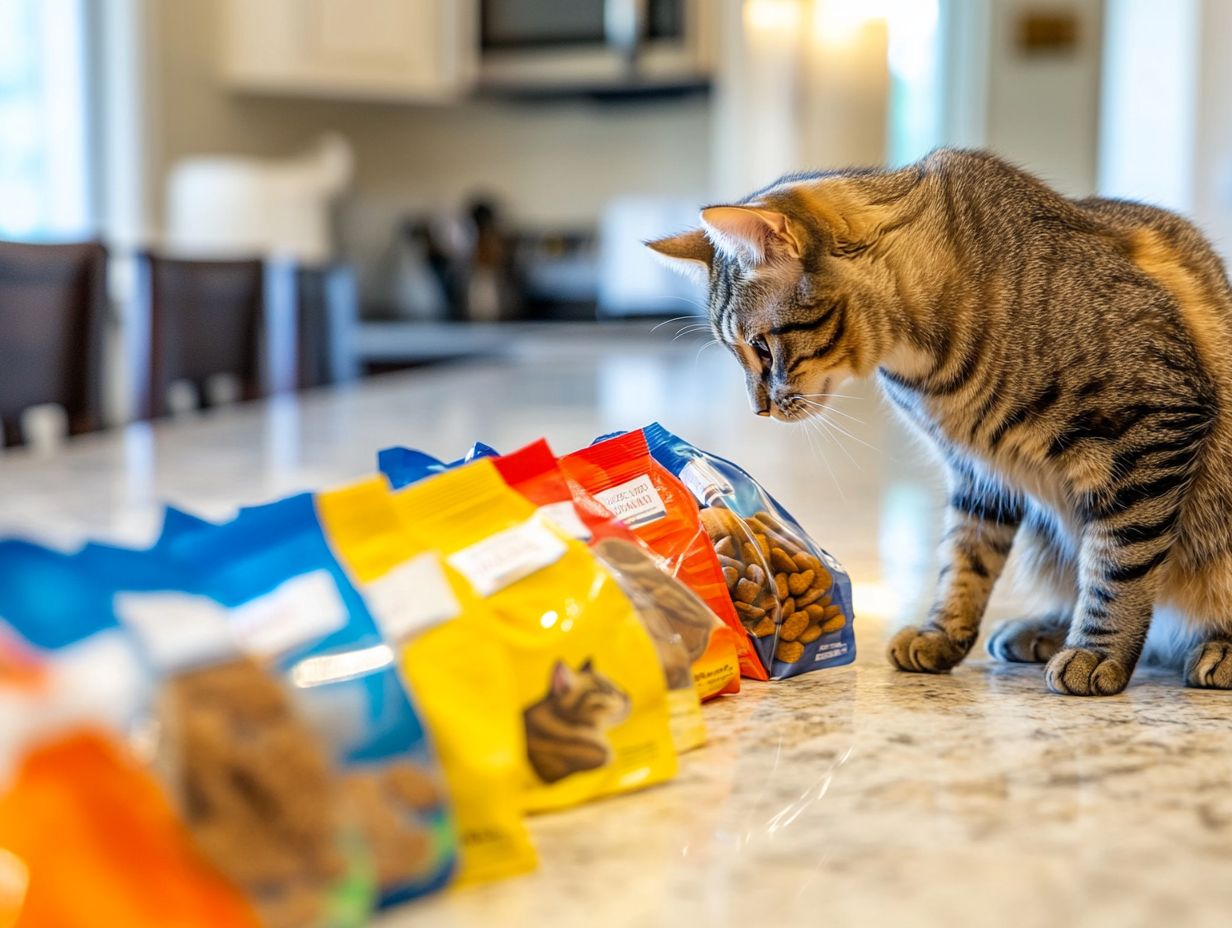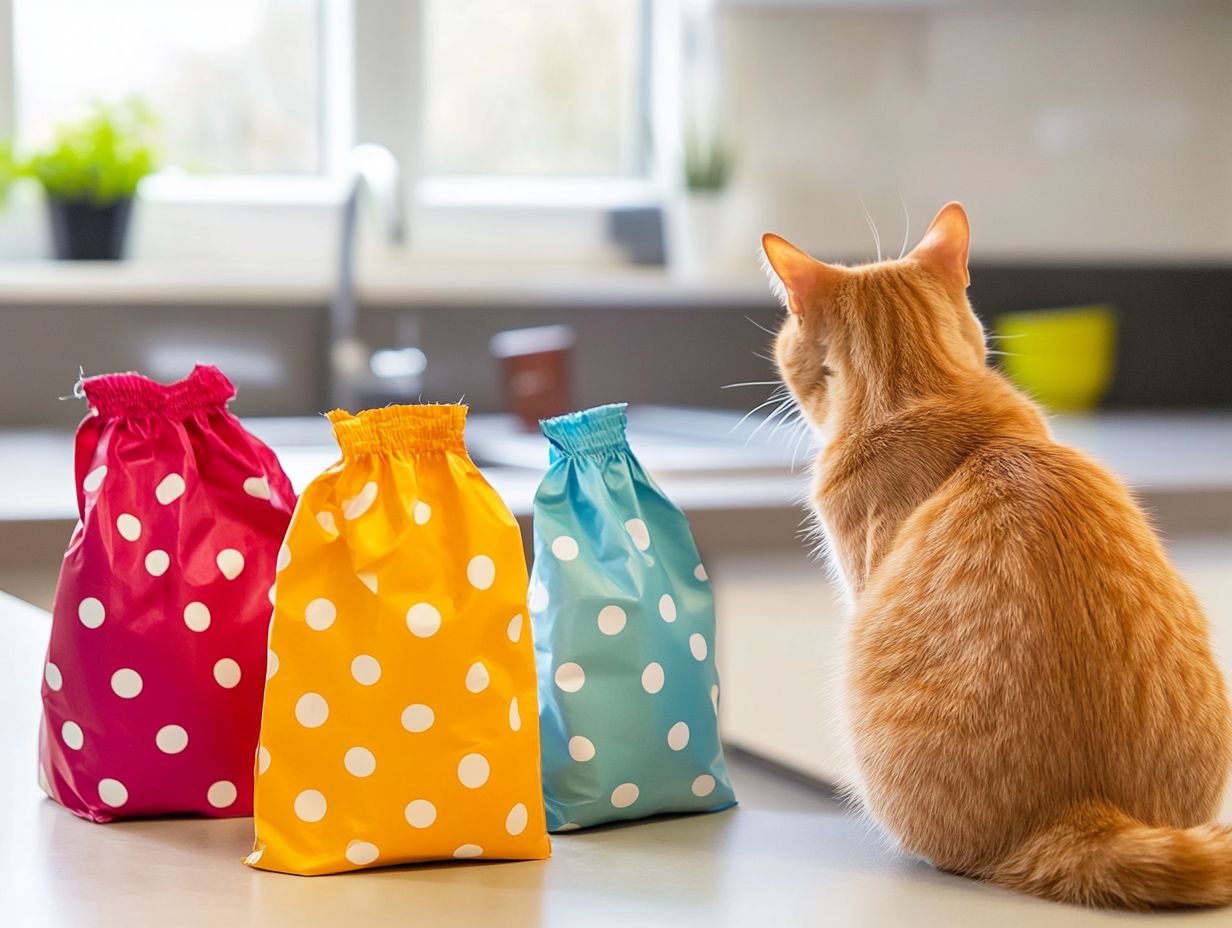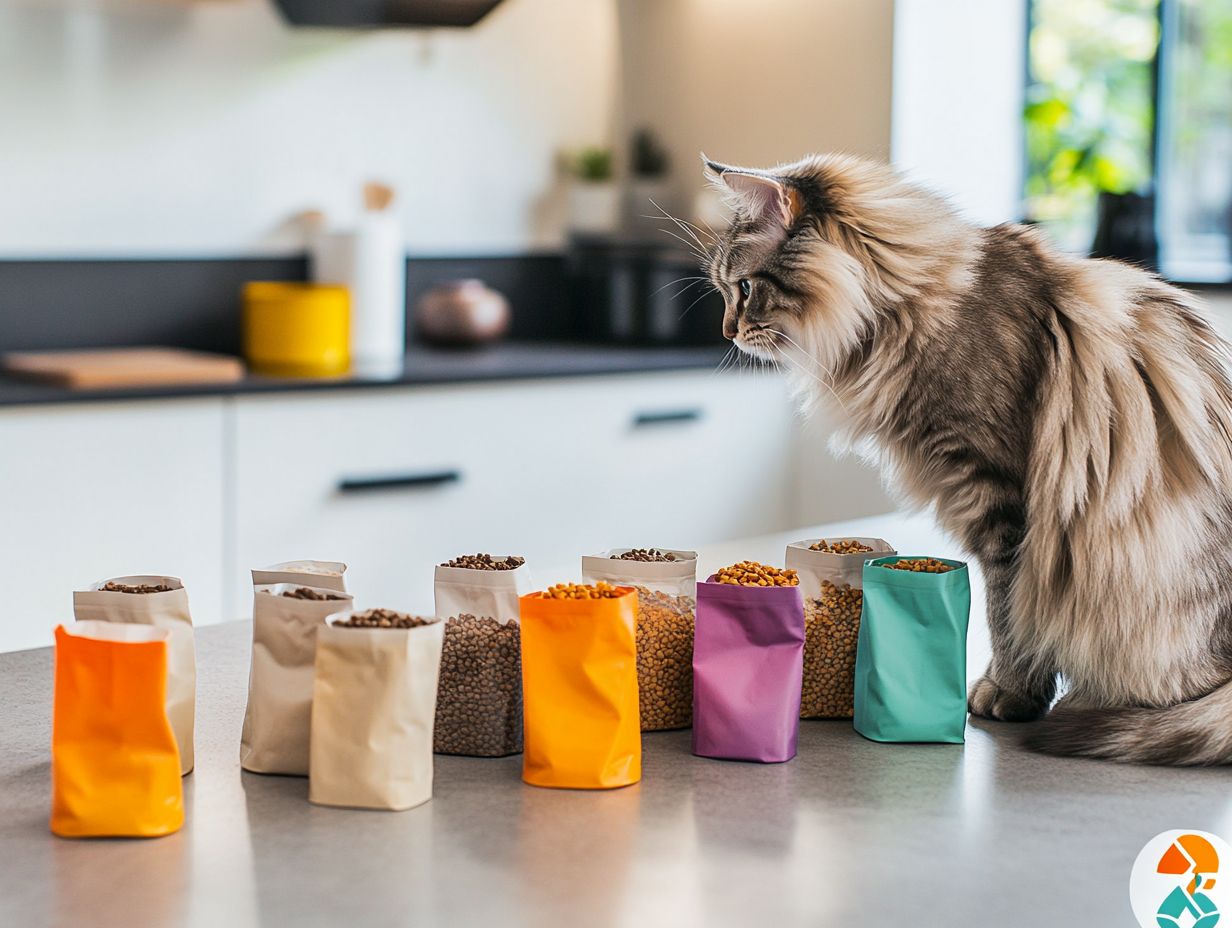Finding the right cat food can be a daunting task, especially when managing weight issues, such as obesity, in cats.
With so many options available, it’s crucial to identify the best low-calorie choices that satisfy your cat’s taste buds, support their overall health, and address potential health issues like diabetes mellitus and osteoarthritis.
This article explores various types of low-calorie cat foods, offers tips for selecting the right one, and highlights common pitfalls to avoid, ensuring your cat’s nutritional requirements are met.
Your cat’s wellbeing and happiness, including weight control and dietary needs, are just a few paragraphs away!
Key Takeaways:

- Choose low-calorie cat food based on your cat’s individual needs, including breed, age, and activity level.
- Monitor portion sizes and transition gradually to a new food to prevent gastrointestinal upset and ensure effective weight management.
- Consult with your veterinarian, who may recommend a prescription diet that is AAFCO-approved, and read labels carefully to avoid common mistakes and provide balanced nutrition for your cat.
What Are the Best Low-Calorie Cat Food Options?
The best low-calorie cat food options take into account the specific dietary needs of your cat, especially in light of the growing obesity epidemic among felines. According to the Association for Pet Obesity Prevention, 59% of cats, including indoor cats and those that are neutered, were classified as overweight or obese in 2021.
This statistic underscores the importance of weight management for cat owners, which can be achieved by providing high-quality, nutritious food formulated for healthy weight maintenance. Consulting with veterinary nutritionists can assist you in making the right choices tailored to your cat’s specific needs and preferences.
As obligate carnivores, cats require animal-source proteins to thrive. This essential nutrient supports their overall health and metabolism.
1. Dry Food
Dry food is a popular low-calorie option among cat owners due to its convenience and ability to help manage portion sizes for weight control. Along with its practicality, this type of food has a long shelf life, allowing pet owners to stock up without concerns about spoilage.
Brands like Hill’s Science Diet and Royal Canin specifically formulate their dry food to offer a high protein content and a nutrient-rich profile, ensuring that felines receive the calories they need. However, while dry food can help reduce dental plaque, it should not be viewed as a substitute for regular dental care, including veterinary check-ups.
Additionally, dry cat food promotes dental health and is often enriched with glucosamine for joint health. This type of food serves the dual purpose of making feeding easier for caregivers and helping cats maintain a healthy weight through proper portion control.
2. Wet Food
Wet food is an excellent option for low-calorie cat diets, as it provides essential hydration and meets the nutritional needs of felines while supporting weight loss efforts. This type of diet can be particularly beneficial for cats that are picky eaters; the palatable texture and rich flavor of wet food often attract even the pickiest of cats.
Many brands, such as Wellness and Hill’s Science Diet, have formulated their wet food specifically to support weight management while ensuring balanced nutrition. These products typically contain high-quality proteins, essential vitamins, and minerals that contribute to overall health and vitality.
Additionally, the higher moisture content in wet food aids digestion and promotes urinary tract health, making it a favorable choice for cat owners seeking to enhance their feline friend’s diet.
3. Prescription Diets
Prescription diets specially formulated for weight management are essential for addressing the health ramifications of obesity in cats, making them a vital component of any cat parent’s strategy for low-calorie feeding.
Veterinary nutritionists play a crucial role in developing and prescribing these diets, carefully considering each individual cat’s medical condition and specific needs.
Through their assessments, veterinary nutritionists create tailored nutritional plans that not only promote effective weight loss but also minimize the risks of obesity-related complications. These prescription diets can lead to numerous positive outcomes, including improved overall health, increased energy levels, and a lower incidence of obesity-related illnesses such as diabetes and joint disease.
It’s essential to consult with your veterinarian before starting any diet, particularly for cats with specific health conditions like kidney disease or diabetes. This ensures a tailored dietary plan that best meets your cat’s needs.
Food Storage and Handling
Proper food storage and handling practices are vital for keeping your cat’s food safe and fresh. Always check expiration dates, store food in a cool, dry place, and seal containers tightly after use. Look for signs of spoilage, such as unusual odors or changes in texture.
Reading ingredient labels is also crucial, especially for cats with known sensitivities or potential allergens. Being aware of the ingredients can help you select the right food that aligns with your cat’s health requirements.
Considerations for Different Life Stages
Different life stages, such as kittens, seniors, and pregnant or nursing cats, require specific dietary needs. Ensure the food you select meets these unique requirements to promote optimal health at every stage of your cat’s life.
In conclusion, always prioritize veterinary guidance when selecting a diet for your cat. Consult your veterinarian for personalized dietary recommendations that cater to your cat’s specific health needs and lifestyle.
Adhering to these prescribed diets is critical, as maintaining the proper nutritional balance is key to ensuring the health and longevity of our feline companions, whose obligate carnivore nature necessitates animal-source proteins in their diets, contributing to their happiness and well-being.
How to Choose the Right Low-Calorie Cat Food Specifically Formulated for Cats?
When selecting low-calorie cat food specifically formulated for cats, it’s important to consider several factors, including the ingredients, the cat’s age, its activity level, and any specific dietary requirements to ensure the food meets its overall health needs.
1. Check the Ingredients List

When selecting low-calorie cat food, it is crucial to examine the ingredients to ensure the food provides a balanced nutritional profile that meets your cat’s dietary needs. From this perspective, several key aspects deserve attention.
According to a veterinarian at the University of Illinois College of Veterinary Medicine, high-quality protein sources, such as real meat or fish, should be the primary ingredients. Proteins are essential building blocks that help cats maintain their muscle mass, particularly during weight management.
Additionally, fiber-rich ingredients, like peas or brown rice, are important for aiding digestion and helping your cat feel full. However, while fiber is beneficial, excessive amounts can lead to gastrointestinal issues; balance is key. The inclusion of essential vitamins and minerals is also vital for overall health. It is advisable to look for AAFCO-approved formulations, which meet nutritional adequacy standards, and to avoid fillers and artificial additives, as they do not contribute any nutritional value and may lead to long-term health issues in cats.
Also, be aware of potential allergens and toxic ingredients, advising cat owners to be mindful of any allergies their pets may have.
2. Consider Your Cat’s Age and Activity Level
The age and activity level of your cat significantly influence their dietary needs, making it essential to choose low-calorie cat food based on these factors for optimal health outcomes.
As cats age, their metabolism slows, and their nutritional requirements change, often necessitating a switch to formulations that are lower in calories yet rich in essential nutrients. For example, senior cats may benefit from diets high in protein to help maintain muscle mass while being lower in fat to prevent obesity.
Senior cats may also have special dietary needs related to conditions such as kidney disease or diabetes, thus requiring veterinary consultation for tailored diets.
Conversely, more active cats require diets that provide energizing sources to support their overall vitality and playfulness. Tailoring a cat’s diet not only helps maintain energy levels but also supports vital bodily functions, underscoring the importance of proper dietary choices for a cat’s longevity and quality of life.
3. Consult with Your Veterinarian
Consulting a veterinarian is a crucial step in selecting low-calorie cat food to manage your cat’s weight and associated health risks, such as respiratory disorders and liver disease. Veterinarians can evaluate your cat’s specific health circumstances, including its age, breed, and any pre-existing medical conditions.
By having a professional assess your cat’s nutritional requirements, you can avoid the limitations of off-the-shelf brands that may not meet the necessary dietary specifications. Some cats may require prescription diets, particularly those with specific health issues, reinforcing the importance of professional guidance. Veterinarians can recommend specific formulations that promote healthy weight loss or maintenance, ensuring your cat receives balanced nutrition tailored to its lifestyle.
This knowledge-based decision making helps safeguard your pet’s health and strengthens the bond between you and your cat.
What Are Some Tips for Feeding Low-Calorie Cat Food?
Several strategic tips can help in feeding low-calorie cat food. These include:
- Monitoring portion sizes to maintain calorie needs
- Gradually transitioning to the new food to support fat metabolism
- Ensuring that your cat has access to plenty of fresh water to promote optimal digestive health and prevent urinary tract disease
- Recognizing signs of obesity or weight loss, encouraging regular health check-ups
1. Monitor Your Cat’s Portion Sizes
Monitoring portion sizes for low-calorie cat food is essential for effective weight management and overall health. Understanding the best methods for measuring these portions can enhance their effectiveness.
During the early stages of a cat’s life, providing specific portion sizes is crucial. While measuring cups can offer a rough estimate, using kitchen scales allows for more accurate serving sizes based on your pet’s unique caloric needs.
Although these recommendations may vary depending on a cat’s weight, portion sizes for low-calorie food also take into account the individual’s age, activity level, and any pre-existing health issues. A cat’s body condition score can further assist in adjusting the portions of low-calorie foods, as leaner cats may require different proportions than those that are slightly overweight. It is essential to adhere to current veterinary nutrition standards, including references to relevant AAFCO and WSAVA guidelines, particularly when discussing weight management.
Adhering to the recommended serving sizes helps ensure that your pet maintains a healthy weight and avoids complications related to obesity. Remember, cats are obligate carnivores, and their diet must primarily consist of animal-source proteins, even when selecting low-calorie options.
2. Gradually Transition to a New Food
A gradual transition to a new low-calorie cat food is essential for helping your cat’s digestive system adjust to the new diet and ensuring they can adapt to the new nutritional requirements without issues. This process should be approached carefully, as a sudden change in diet can lead to gastrointestinal upset. It is highly recommended to consult your veterinarian to tailor the transition process according to your cat’s individual health status and dietary needs.
Start by mixing small amounts of the new food with the current brand, gradually increasing the proportion of the new food until the transition is complete over the course of about a week. During this period, closely monitor your cat’s behavior and the consistency of their stools, as these factors indicate how well the new food is being tolerated. If your cat experiences any discomfort, such as diarrhea or vomiting, it’s important to slow down the transition and consult your veterinarian. A gradual approach, along with some patience, is crucial in preventing tummy troubles and ensuring a smooth transition.
3. Provide Plenty of Fresh Water

Ensuring that your cat has access to a sufficient amount of fresh water is essential when feeding them low-calorie cat food, as it supports the overall functioning of their body. Proper hydration aids digestion, making it easier for cats to break down nutrients efficiently, which allows them to fully benefit from their food. Additionally, hydration is crucial not just for kidney function but also for preventing urinary tract diseases, which are common in cats.
Furthermore, adequate water intake facilitates kidney function and reduces the risk of urinary tract disease. Incorporating water into their diet can also help address issues like obesity and constipation, enabling cats to maintain their weight while still enjoying their meals. Ultimately, providing a balanced diet and proper hydration contributes to your pet’s overall health and activity levels. Regular veterinary exams can further ensure your cat’s digestive health.
4. Avoid Free-feeding
Establishing a feeding schedule for your cat is crucial when managing their diet with low-calorie cat food, as free-feeding can lead to overeating and hinder effective weight management. Without designated feeding times, cats may consume excessive amounts of food without their owners noticing, making it difficult to track their calorie intake. This can lead to unwanted weight gain and a range of health implications later on, including diabetes and joint problems.
By implementing set feeding times and measuring portion sizes, owners can promote healthier eating habits in their cats, ensuring they receive the necessary nutrients while maintaining an appropriate weight. This straightforward approach allows owners to take control of their pets’ diets and fosters accountability for their cats’ eating habits. For those interested in healthier options, check out Low-Calorie Cat Food: Top Choices for Effective Weight Management, which may include Royal Canin and Purina Pro Plan options.
What Are Some Common Mistakes to Avoid When Feeding Low-Calorie Cat Food?
When feeding low-calorie cat food, it’s important to avoid common mistakes. These include:
- Failing to consider the individual needs of the cat,
- Neglecting to monitor its weight regularly, which can lead to serious health issues, including diabetes and joint problems;
- Not providing sufficient nutrients to support the cat’s overall health and potentially causing nutritional deficiencies if the diet is not properly formulated.
1. Not Considering Your Cat’s Individual Needs
One common mistake that cat owners make is neglecting to consider their cat’s specific needs when selecting low-calorie cat food, which can result in poor nutrition and negative health outcomes.
A cat’s individual dietary requirements should be assessed, as factors such as age, breed, and health conditions significantly influence their nutritional needs. As obligate carnivores, cats require a diet primarily consisting of animal-source proteins, which are essential for their health. For instance, male cats and certain cat breeds like American Shorthair or British Shorthair may have unique needs. A young kitten has different dietary requirements compared to an older cat, whose metabolism may vary based on breed or existing health issues, such as chronic kidney disease or diabetes. It is advisable for pet owners to consult their veterinarian before making significant dietary changes, especially regarding special dietary needs.
By choosing food tailored to these specific needs, owners can ensure that their cats receive the right amount of nutrients. This not only promotes overall health and well-being but also helps cats achieve a healthy weight, increased energy, and a longer lifespan.
2. Not Monitoring Your Cat’s Weight
Monitoring your cat’s weight is crucial when feeding low-calorie cat food, as it is the best way to assess the diet’s success and your cat’s overall health. Ideally, tracking weight changes should be a regular part of a cat owner’s responsibilities, as fluctuations can lead to serious medical issues over time. It is advisable to weigh your cat at least once a month on an appropriate scale, such as a digital pet scale, and document any changes. Establishing a baseline weight is important for comparison. For those looking to manage their cat’s weight effectively, consider exploring low-calorie cat food options.
Variations in weight, along with changes in activity or appetite, may warrant further investigation. If significant weight changes occur or if you notice other unusual behaviors, it is important to seek intervention from a veterinarian to ensure your pet’s health. However, pet owners should be aware of the potential risks of low-calorie diets, such as nutritional deficiencies, and ensure that any low-calorie food meets the AAFCO nutrient profiles for complete and balanced cat food.
3. Not Providing Enough Nutrients
Failing to provide sufficient nutrients in low-calorie cat food can result in inadequate nutrition and potential health issues, making it essential to ensure a balanced nutrient profile in your cat’s diet. Essential vitamins and minerals such as taurine, arachidonic acid, and vitamins A and E are crucial for a cat’s health. Consultation with veterinary nutritionists can guide in selecting the right prescription diets if needed.
A well-rounded diet should include essential vitamins, minerals, and adequate protein, all of which are vital for a cat’s overall health and vitality. Cats require various nutrients to maintain strong immune systems, healthy skin, and a shiny coat, as well as to support their energy levels. Ingredients like omega-3 fatty acids and antioxidants can further enhance their immune system health.
When selecting cat food, pet owners must remember that simply limiting calories is not enough; the quality of those calories is also important. An optimal diet ensures that felines receive the necessary nutrients for growth and sustenance without excess, helping to prevent obesity and related diseases.
4. Not Reading the Labels

Another common mistake is neglecting to read the labels of low-calorie cat food, which can result in poor ingredient choices and negative health outcomes for your cat. Understanding the significance of the ingredients listed is crucial for ensuring the nutritional quality of the food, especially for indoor cats versus outdoor cats. Indoor cats may require fewer calories due to lower activity levels, underscoring the importance of tailored diets for different lifestyles.
By closely examining the product’s label, pet owners can better assess the presence of high-quality proteins versus fillers, artificial additives, and preservatives that may be unnecessary in a cat’s diet. Specific harmful ingredients to look out for include certain artificial preservatives like BHA or BHT, which may pose health risks. Analyzing these details can help in selecting food that promotes optimal health and longevity, reducing the risk of feline lower urinary tract disease.
Failing to consider this information may lead to nutrient deficiencies or imbalances, which can manifest as reduced energy levels, poor fur quality, or even long-term health issues for the cat. This highlights the importance of being an informed consumer and recognizing the role of quality ingredients in feline diets. Practical tips for reading labels include looking for named meat sources, such as “chicken meal” instead of just “meat meal,” and understanding the ingredient order.
Frequently Asked Questions
What is low-calorie cat food?
Low-calorie cat food is specifically designed for cats who need to lose weight or maintain a healthy weight. These foods are lower in calories and fat compared to traditional cat food, typically ranging from 200 to 300 calories per cup, but still provide all the necessary nutrients for your cat’s overall health, supporting weight control and portion control.
Why is it important to choose a low-calorie cat food for weight management?
Choosing a weight management cat food is important for weight management because obesity can lead to various health issues, such as diabetes, joint problems, and heart disease. By feeding your cat a weight management diet, you can help them maintain a healthy weight and reduce their risk of developing these health problems. This can also combat the obesity epidemic affecting many overweight cats today. It’s essential to monitor your cat’s body condition score and consult your veterinarian regularly to adjust the diet as necessary.
What are some top choices for weight management cat food?
Some top choices for weight management cat food include Blue Buffalo Healthy Weight Formula, Hill’s Science Diet Perfect Weight, and Purina Pro Plan Weight Management Formula. These brands offer high-quality, nutritionally balanced options for cats looking to lose weight, featuring fiber-rich and palatable formulas. Additionally, these brands comply with AAFCO feeding trials and guidelines, ensuring that they meet recognized standards for nutritional adequacy.
How do I determine the right amount of weight management food to feed my cat?
The amount of weight management cat food to feed your cat will depend on their age, weight, and activity level. It’s best to consult with your veterinarian to determine the appropriate portion size for your cat’s specific needs. You should also follow the feeding guidelines on the food packaging and consider feeding trials designed to assess long-term weight management strategies, not just short-term weight loss.
Can I switch my cat’s food to a weight management option without consulting a veterinarian?
It’s always best to consult with your veterinarian before making any significant changes to your cat’s diet. They can provide personalized recommendations based on your cat’s health and weight management needs, including weight loss goals. A sudden switch to a weight management food can cause digestive upset and may lead to nutritional deficiencies if the diet is not well-balanced, so it’s best to transition gradually.
Are there any potential drawbacks to feeding my cat a weight management diet?
While a weight management diet can be beneficial for weight management, it’s essential to ensure your cat is still receiving all the necessary nutrients. Some weight management cat foods may be lacking in certain vitamins and minerals, including vital animal-source proteins essential for obligate carnivores. Therefore, it’s important to choose a high-quality brand and potentially supplement with any missing nutrients if advised by your veterinarian. Consider prescription diets and nutrient balance to ensure your cat’s dietary needs are met.
Considerations for Different Life Stages
When considering weight management diets, it’s crucial to account for specific life stages, such as kittens and senior cats, as their nutritional needs differ significantly. Consulting with a veterinary nutritionist can help create personalized diet plans, especially for cats with specific health conditions such as diabetes or kidney disease.
Food Storage and Handling
Proper food storage and handling practices are essential to prevent spoilage, which can impact the safety and nutritional quality of cat food. Ensure that the food is stored in a cool, dry place and that any opened packages are sealed tightly to maintain freshness.
Ethical Considerations
Lastly, it’s important to consider the ethical aspects of feeding commercial diets versus homemade or raw diets. Regardless of the choice, the priority should always be to meet your cat’s nutritional needs first.